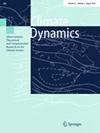极端气候变化下AMOC的弱化
IF 3.7
2区 地球科学
Q2 METEOROLOGY & ATMOSPHERIC SCIENCES
引用次数: 0
摘要
摘要:研究了第6次耦合模式比对项目(CMIP6)四次co2试验中大西洋经向翻转环流(AMOC)的变化。二氧化碳的增加引发了广泛的北极变暖,造成了广泛的海冰融化。由此产生的淡水首先从拉布拉多海和北欧海向南扩散,然后沿着北美东海岸扩散。淡水进入分离的墨西哥湾流以北的亚极地环流,即北大西洋洋流。这降低了水流的密度梯度,水流随之减弱,减少了深水生产区的流入。AMOC单体是串联减弱的,首先在北大西洋洋流附近减弱,然后向高纬度和低纬度扩散。这与通常认为淡水覆盖对流区、抑制深水生产的看法形成了鲜明对比;相反,流入亚极环流的气流被抑制了。地表温度变化的影响要弱得多,各模式之间的局地或远地风强迫没有一致的变化。因此,在这些模拟中,主要来自拉布拉多海的淡水排放量的增加是AMOC减弱的前兆。本文章由计算机程序翻译,如有差异,请以英文原文为准。
The weakening AMOC under extreme climate change
Abstract Changes in the Atlantic Meridional Overturning Circulation (AMOC) in the quadrupled CO 2 experiments conducted under the sixth Coupled Model Intercomparison Project (CMIP6) are examined. Increased CO 2 triggers extensive Arctic warming, causing widespread melting of sea ice. The resulting freshwater spreads southward, first from the Labrador Sea and then the Nordic Seas, and proceeds along the eastern coast of North America. The freshwater enters the subpolar gyre north of the separated Gulf Stream, the North Atlantic Current. This decreases the density gradient across the current and the current weakens in response, reducing the inflow to the deepwater production regions. The AMOC cell weakens in tandem, first near the North Atlantic Current and then spreading to higher and lower latitudes. This contrasts with the common perception that freshwater caps the convection regions, stifling deepwater production; rather, it is the inflow to the subpolar gyre that is suppressed. Changes in surface temperature have a much weaker effect, and there are no consistent changes in local or remote wind forcing among the models. Thus an increase in freshwater discharge, primarily from the Labrador Sea, is the precursor to AMOC weakening in these simulations.
求助全文
通过发布文献求助,成功后即可免费获取论文全文。
去求助
来源期刊

Climate Dynamics
地学-气象与大气科学
CiteScore
8.80
自引率
15.20%
发文量
483
审稿时长
2-4 weeks
期刊介绍:
The international journal Climate Dynamics provides for the publication of high-quality research on all aspects of the dynamics of the global climate system.
Coverage includes original paleoclimatic, diagnostic, analytical and numerical modeling research on the structure and behavior of the atmosphere, oceans, cryosphere, biomass and land surface as interacting components of the dynamics of global climate. Contributions are focused on selected aspects of climate dynamics on particular scales of space or time.
The journal also publishes reviews and papers emphasizing an integrated view of the physical and biogeochemical processes governing climate and climate change.
 求助内容:
求助内容: 应助结果提醒方式:
应助结果提醒方式:


